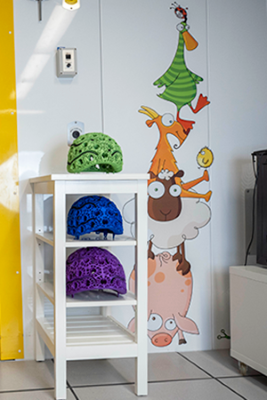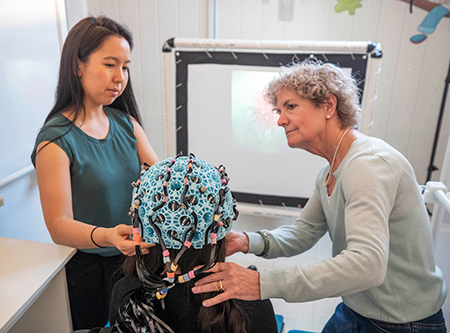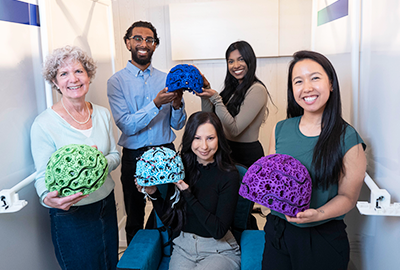Wearable brain scanner is helping researchers unravel the mysteries of the developing brain
Summary:
In an ongoing study, SickKids scientists are using exciting technology to gather data on early brain development and inform new research on autism spectrum disorder.

In a colourful room at The Hospital for Sick Children (SickKids), children and their caregivers are greeted by a friendly research team and a bin filled with toys as they wait to participate in a novel and non-invasive brain imaging study. On a table in front of them, several lightweight helmets – one blue, one green, one purple, and one aqua – are causing a buzz in the room.

The helmets are not just helmets. They contain wearable sensors that give the research team an ability to measure brain activity like traditional magnetoencephalogram (MEG) or electroencephalogram (EEG) technology but with one major difference – they allow the children to move while wearing them.
It’s a game changing MEG technology using OPMs (optically pumped magnetometers) that Dr. Margot Taylor, a Senior Scientist at SickKids, is employing as part of a new research study to understand brain development in young children with and without autism spectrum disorder (ASD).
“Until now we haven’t had access to technology that can capture clear readings of brain function in very young children,” explains Taylor, who is also the Director of Functional Neuroimaging. “Now, we can finally start to uncover the mystery of the young brain and get fresh insights into the brain patterns associated with autism spectrum disorder.”
Changing the brain imaging experience
As the child plays with toys or waits with their parents, the research team conducts a developmental assessment and takes precise measurements of their head. This information is used to arrange a network of sensors within a lightweight helmet so they can get the best readings the first time a child’s brain activity is measured.
Traditional MEG and EEG technology, which record magnetic and electrical activity in the brain, require young children to be very still for periods of time, and in the case of EEGs require the placement of many electrodes onto the child’s scalp.
“Traditional MEG is like putting a small child in a huge salon hairdryer – for children, this makes results less detailed, and the experience is understandably intimidating,” explains Taylor, who works in the Neurosciences & Mental Health program at SickKids Research Institute. “This OPM technology is ideal for young children and people who would have difficulty producing clear readings using traditional approaches that require them to stay very still.”

Once ready, the family is led through a door into a small room with cartoons on the walls, where a large chair in front of a projection screen awaits them. A series of stimuli and videos, from popular children’s shows to other videos specifically designed to be relaxing, help the research team to measure the brain both in response to specific stimuli and at rest.
“Having a child sit still for any period of time can be a challenge. One of the ways we can keep children engaged is by playing their favourite shows in between standard task videos we show to get specific brain readings,” says Dr. Kristina Safar, a Research Associate in the Department of Diagnostic Imaging. “Unlike traditional imaging methods, which can be a scary experience for some participants, in our study the child and their caregiver can be together, the child can be on the parent’s lap, even while we’re collecting important research data.”
“We had never seen such detailed functional recordings in children this young before.”
Dr. Margot Taylor
While the child watches the videos, brain readings start to emerge on a series of monitors in the adjoining room. The readings from the OPM sensors are highly detailed regardless of any fidgeting or movement from the child. After only a few minutes, the brain recording is complete and both caregiver and child come back into the main space to fill out a quick questionnaire.
“Our research aims to open the doors to the brain during a period of life which has remained largely unresearched due to the challenges of recording brain responses at this age,” says Taylor, who is the first scientist in Canada to use this wearable OPM-powered MEG. “Thanks to this technology, we can start to change the way young children and their families interact with research.”
“When I learned about this study, I was excited for my two daughters to participate in the control group and be some of the first children in Canada to access this unique and care-changing technology. The process was smooth from start to finish. Our eldest daughter in particular showed amazingly clear results during the scan, while our youngest breezed through the neurocognitive assessment playing with toys and games. As a researcher myself, I know it’s important to expose children to science from a young age, and participating in a study like this is a great way to start.”
Dr. Dafna Sussman
Parent of two research participants
Principal Investigator in the MFI Laboratory at Toronto Metropolitan University (TMU)
ASD study is currently recruiting research participants

ASD is a condition that most commonly results in challenges related to communication, social understanding and repetitive behaviours. The condition occurs in approximately one to two per cent of the population, but scientists have yet to characterize how it affects brain activity in early childhood, in large part because of the limitations of fMRI, EEG and traditional MEG.
Taylor and her team are currently recruiting young children between one and four years old, with or without a diagnosis of ASD, to participate in a research study.
“This is such an exciting time to be researching the brain, and the potential use of this technology could extend beyond ASD to other conditions,” says Dr. Julie Sato, a Postdoctoral Research Fellow in the Neurosciences & Mental Health program working on the study. “The use of innovative technology is enabling us to improve the patient and family participant experience in research and hopefully gather information that could inform new perspectives on autism spectrum disorder.”
Participate in the study
If your child is between one to five years old with a diagnosis of autism spectrum disorder, your child and any neuro-typical siblings may be eligible to participate in this study. The study is also currently recruiting children aged one to five without a family diagnosis of autism to act as a control group. The research team will work with you and your family to accommodate your schedule. Contact babiesandtoddlers.science@sickkids.ca to learn more.

